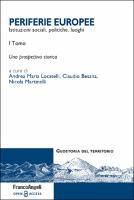Periferie europee
Istituzioni sociali, politiche, luoghi - 2 tomi indivisibili
| dc.contributor.editor | Locatelli, Andrea Maria | |
| dc.contributor.editor | Molinari, Paolo | |
| dc.contributor.editor | Besana, Claudio | |
| dc.contributor.editor | Martinelli, Nicola | |
| dc.date.accessioned | 2022-03-28T15:32:09Z | |
| dc.date.available | 2022-03-28T15:32:09Z | |
| dc.date.issued | 2021 | |
| dc.identifier | ONIX_20220328_9788835125228_26 | |
| dc.identifier | OCN: 1313555552 | |
| dc.identifier.uri | https://library.oapen.org/handle/20.500.12657/53645 | |
| dc.language | Italian | |
| dc.relation.ispartofseries | Geostoria del territorio | |
| dc.subject.classification | thema EDItEUR::K Economics, Finance, Business and Management::KC Economics::KCZ Economic history | en_US |
| dc.subject.classification | thema EDItEUR::R Earth Sciences, Geography, Environment, Planning::RG Geography::RGC Human geography::RGCM Economic geography | en_US |
| dc.subject.other | Urban peripheries, Europe, History, Economic history, Geography, Institutions, Social forces, Social policies, Urban regeneration | |
| dc.title | Periferie europee | |
| dc.title.alternative | Istituzioni sociali, politiche, luoghi - 2 tomi indivisibili | |
| dc.type | book | |
| oapen.abstract.otherlanguage | In the rich Western societies, the several crises at the beginning of this century focus on the worsening of old economic and social problems, which have taken on new importance in the cities undergoing a rapid transformation because of the globalization and the new structures of the labor market. These are issues that have called into question the traditional political systems, with significant effects on the evolution of democratic systems. These issues have been raised throughout the 20th century and today they are once again central to the structural transformations aforementioned and to the crisis of the welfare systems built in Europe during the so-called Golden Age. The theme of living in the peripheries reappears in a dramatic way; a problem exacerbated by the fact that today these areas are no longer just those outside the cities (shaped by the processes of the economic modernization of the 19th and 20th centuries) but they deeply characterize the urban fabric and are linked to the existential conditions of those who live there. The book combines historical and geographical perspectives, according to an interdisciplinary approach. It is possible to examine the policies adopted and to be adopted in these territories and the role that social forces and associative networks have played and can play in identifying adequate and durable responses to such complex problems. A long-term view and a more systemic analysis allow a reflection on the relationship between socio-economic development and the processes of construction of the living together in the different contexts of European cities. Social actors, in their various forms, have offered and are able to offer strategic contributions for the production of new development models, in which the quality of life in working-class peripheries and the processes of social inclusion will be once again a priority, as required by the urban agendas of this new millennium. | |
| oapen.relation.isPublishedBy | e2ddfb5e-9202-4851-8afe-1e09b020b018 | |
| oapen.relation.isbn | 9788835125228 | |
| oapen.pages | 361 | |
| oapen.pages | 187 | |
| oapen.place.publication | Milan |

